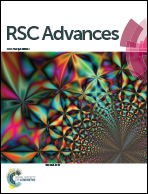Interpenetrated 3D porous scaffolds of silk fibroin with an amino and octadecyl functionalized hyaluronic acid
Abstract
An ethylenediamine (EDA) and octadecylamine (–C18) hyaluronic acid (HA) derivative, named HA–EDA–C18, has been used for the production of interpenetrated composite biomaterials with silk fibroin. The peculiar ionic strength sensibility of this HA derivative allows the production of porous matrices without the need for chemical crosslinking. Scaffolds have been produced through a salt leaching procedure by exploiting the properties of silk fibroin and HA–EDA–C18 to physically crosslink when forced through a syringe loaded with NaCl. The porosity of the sponges, comprised between 70–80%, was dependent on the amount of each polymer and NaCl size distribution. Moreover, through FT-IR analysis, it has been evaluated how the blend composition influences the conformational changes of fibroin. This study demonstrates that HA–EDA–C18 induces the transition of silk fibroin to its β-sheet conformation. Moreover, the HA–EDA–C18 weight fraction in composite sponges regulates the scaffold susceptibility to protease and hyaluronidase. FT-IR analysis and enzymatic hydrolysis studies suggest that the homogeneous interpenetration of polymers occurs. In vitro studies indicate that the presence of fibroin improves the viability and attachment of bovine chondrocytes.


 Please wait while we load your content...
Please wait while we load your content...